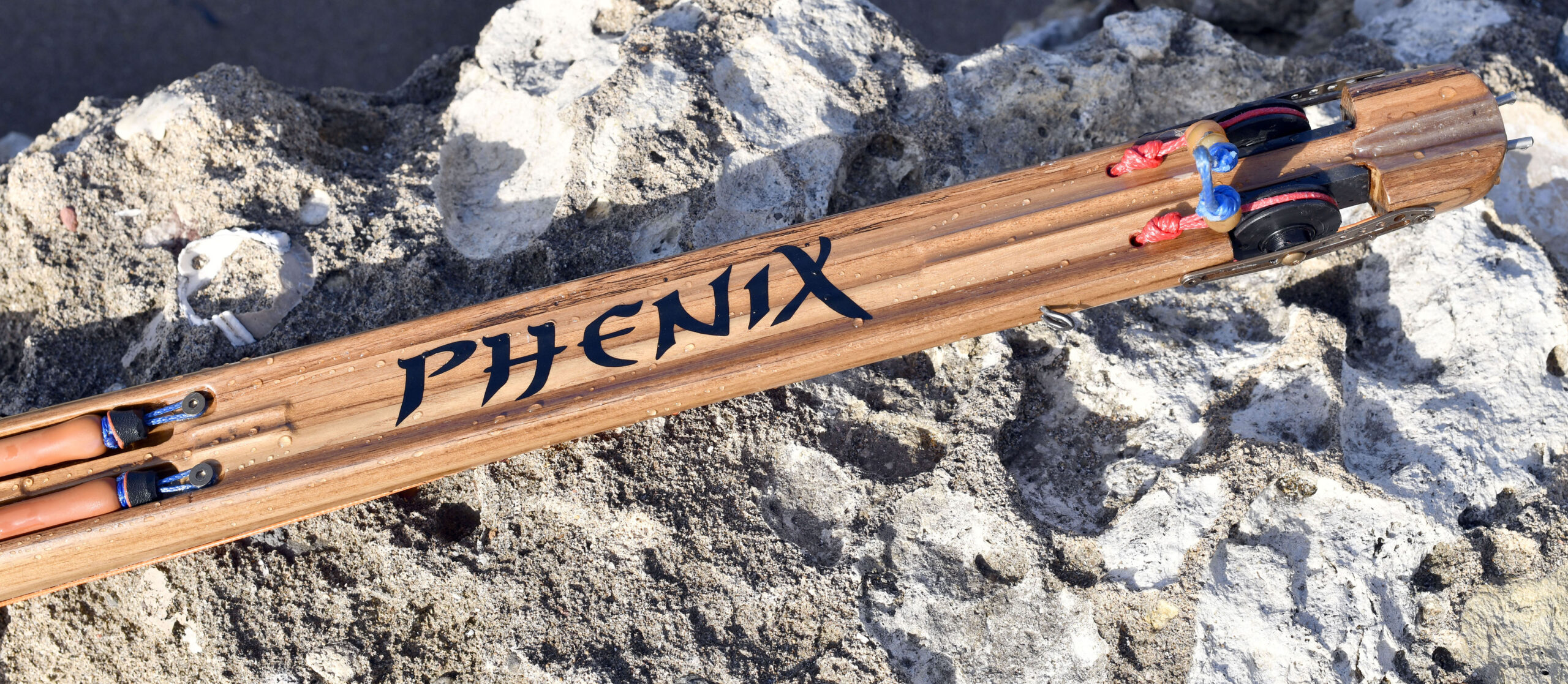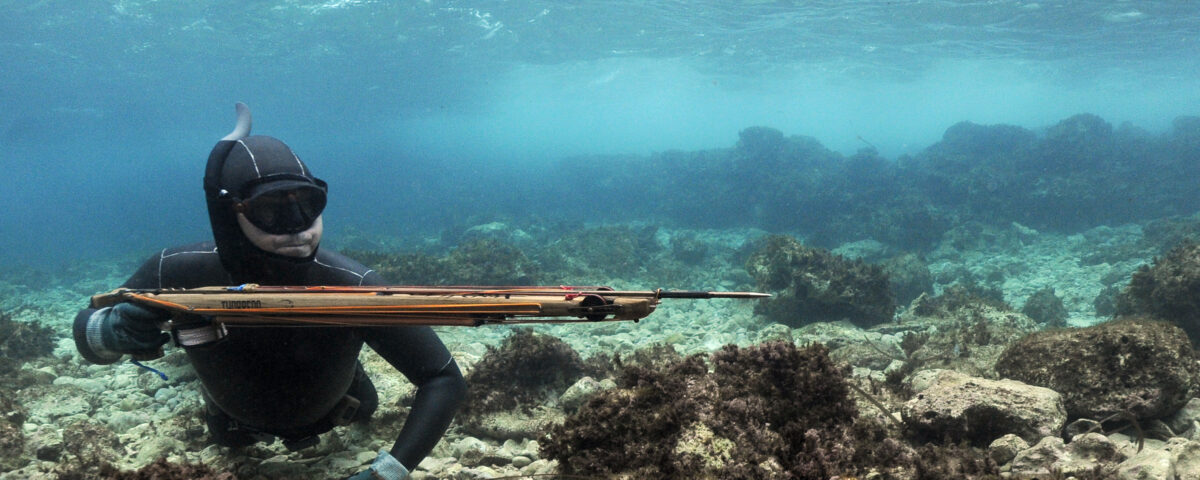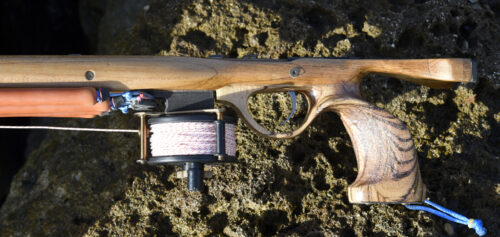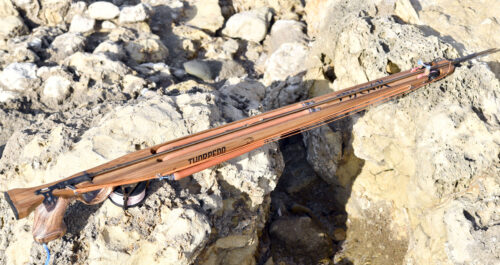Thorpedo: Phenix-Invert 87

Tavolara, the new buoy by C4
7 April 2025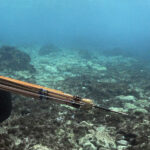
PoloSub: Smoothskin Jacket 6.5 mm and Single-lined Pants 5.5 mm
10 April 2025A beautiful speargun equipped with the vela propulsion system—perfect for hunting whitefish in medium and shallow waters
Emanuele Zara
It had been a while since I tested a speargun from Thorpedo. Then, a couple of months ago, I received their current flagship model: the **Phenix-Invert 87**, featuring the **vela propulsion system** and a laminated **teak barrel**. Every speargun made by this Tuscan company is handcrafted, built one by one, and for this model, particular attention was paid to refining the lines, which are now sleeker.
The height bulk has been reduced, and the inverted propulsion system clears the top of the barrel, improving maneuverability and handling underwater. Normally, the Phenix-Invert features a multi-laminate barrel made from three types of wood—**mahogany, okoumé, and zebrawood**—reinforced with **carbon composite layers** placed between the slats.
The handle, in my opinion, is the most stunning part of the speargun. Made from zebrawood slats, it has a distinctive striped “tiger” effect that varies from one piece to another. I received the right-handed version, but left-handed or ambidextrous grips are also available, all featuring a non-slip surface finish.
The Phenix-Invert series evolved from Thorpedo’s traditional roller models but features sleeker lines. “We’ve made improvements,” said company owner Lorenzo Pellegrini, “and now all our spearguns are tuned for quick and agile hunting. Thanks to recent upgrades, we’ve increased shooting power and drastically reduced recoil, resulting in true ‘fencing foils’ ideal for whitefish hunting in shallow and medium depths.”
The Phenix-Invert series adapts to any situation with **six available lengths** (57, 67, 77, 87, 97, 107 cm) and multiple rigging setups. From size 87 upwards, it can be set up as an **inverter or vela system**.
The test model is an **87 vela setup**, equipped with **three pairs of Thorpedo 16 mm bands** and a **stainless-steel pulley system** (+€70). The barrel is made of **teak/carbon multilaminate**, available on request (+€80). The vela system includes two custom **Delrin pulleys** by Hunt, and minimal **AISI 316 steel guide rails** on the sides. Only two cords run along the top, offering a clear aiming line.
The tensioner for the two lower elastic pairs—mounted underneath and attached to the reel’s stainless steel frame—is custom-designed by Thorpedo and 3D printed in **carbon-reinforced PLA**. Loading is made easier with a multi-step arming process.
The Phenix-Invert lineup supports various propulsion systems: classic roller with dual bands, Y inverter, zero system with progressive pairs (internally-cored upper and non-cored lower bands), and the vela system (from size 87 upwards).
Standard configurations include **6.25/6.5 mm or 6.75 mm shafts**, but can also be rigged with **7 mm Tahitian shafts** and **16 mm bands**, like my test unit.
First Impressions
Testing began on a rough sea day, with surface temps around 15°C.
At first glance, the build quality and aesthetics are stunning. The vela system stands out—designed to integrate perfectly with the overall build. The Phenix-Invert is optimized for streamlined movement and performance: the **inverted dual pulley system** stores high energy and significantly reduces recoil, as the band system works in the opposite direction to the shaft's release.
In the water, I hook the Dyneema wishbone (secured by a stopper at the muzzle) to the first notch via two short bands. The wishbone is connected to two cords running through the head pulleys and under the barrel, engaging the stainless-steel pulley that links both the pretensioned and “free” elastic pairs.
These **16 mm band pairs** can be pretensioned on the molded reel mount or tensioned progressively in multiple steps. The **Oceano shaft**, custom-made by Hunt, features **four low-profile tabs**—two spaced forward and two near the trigger.
Performance: One Word—Exuberant
Once armed, I release the speargun in the water to check balance—it descends slowly, muzzle first.
Gripping the handle, I feel excellent control in the current. For better maneuverability, I recommend the ambidextrous grip, which improves flexibility during aiming.
The Phenix-Invert 87 moves smoothly in the horizontal plane. When I stretch my arm toward a large white seabream hiding in a crevice, I enjoy an uninterrupted field of view. The top is clear of bands, the line barely visible—just me and the target. Unfortunately, the fish spots me before I shoot and bolts.
I push through rocky terrain and find a group of salema feeding. The speargun remains agile and feels light, despite the bulk of the band system underneath, which doesn't hinder performance.
Lining up for a shot, I target a salema. A slight squeeze of the trigger, and the shaft launches—ultra-fast, nearly invisible. A sharp “stak” sound—crisp, with **virtually no recoil**.
The shot is precise—the salema hits the line exactly where I aimed!
I reload. Soon, a group of mullet passes above. I rotate the speargun vertically—fluid motion, low drag. I focus on the largest. The **trigger is ultra-sensitive**, surprising me after a dry land test where it felt like it had a 2 mm travel. In the water, that sensation disappears. A gentle press and the 7 mm shaft rockets forward—**perfect shot**, full penetration. Precision confirmed.
Final Verdict
The new Thorpedo Phenix-Invert is a fantastic project—an inverted propulsion weapon, designed to be **powerful yet not overly complex**, and loaded with premium accessories. In colder winter conditions, a slightly less powerful configuration and a thinner shaft (like 6.75 mm) would also work great.
The Handle
If I had to choose one feature that makes a Thorpedo wooden speargun instantly recognizable, it would be the **handle**. The Phenix-Invert 87 features a **zebrawood right-hand grip**, beautifully sculpted with a pronounced ergonomic curve.
At the base, sealed with a laser-cut stainless plate, there’s a **ballast chamber** to fine-tune buoyancy. The fit and finish between the handle and the teak barrel are exceptional—so precise that the joint is nearly invisible. The **generous trigger guard** highlights the wood’s natural grain, and the **trigger mechanism**, made from **AISI 316 stainless steel**, is rear-positioned, low-profile, and laser-engraved with the brand name.
Internal levers are rounded and polished for minimal friction. The stainless trigger has rounded edges and the correct distance to the finger. All screws and fittings are mounted in **threaded AISI 316L sleeves**—no direct fastening to the wood, which ensures durability. The **butt pad**, or sternal support, also has a dedicated **mounting point for an action cam bracket**.
The Barrel
The test model features a **teak monoblock multilaminate barrel**, including the sternal support at the rear. It’s made from seven aged slats, each selected for grain and appearance. CNC-machined for precision, and reinforced with **carbon composite layers**. Assembly involves **epoxy adhesive under pressure**, followed by hand-finishing.
In traditional Phenix-Invert models, external zebrawood laminates combine with internal **mahogany and okoumé**, and **wengé** in the center. Carbon layers are fully bonded.
About 80 mm from the trigger guard, the barrel has **longitudinal vent holes** (approx. 45 x 15 mm) and deep bilateral grooves, upper and lower, for the band system. Dimensions: approx. 33 mm height, 75 mm width; behind the pulleys: 25 mm height, 46 mm width. The rail is segmented for multiple contact points.
Thorpedo balances each gun, but buoyancy can be tweaked via two ballast compartments: one under the barrel (carbon-covered), another at the handle base (brunished steel insert for weights).
The Muzzle
There isn’t a traditional muzzle. The barrel tip houses **two pulleys** with a through-pin and stainless steel side plates. Two 35 mm wheels are visible in the cutouts, showing carbon layers between the wooden slats.
Underneath is a **dual-line retaining system**, a guide roller, and anchoring holes for the stopper. The shaft is secured by two stainless pins, and the reel line runs through a lower stainless loop.
This final section plays a crucial functional role, hosting key vela components, including **rubber grips** the diver uses for the initial loading—connected to the cords and the pretensioned band pairs operating over the rear pulleys.
Rating
Construction Quality exceptional craftsmanship from wood selection to assembly. Unique handmade pieces:10
Finish outstanding in every detail. Spectacular aesthetics with signature Thorpedo striped handle:10
Balance with a 7 mm shaft, it’s well balanced. Slight muzzle-down tilt. Solid overall: 8
Maneuverability the vela setup offers excellent horizontal and vertical tracking: 8
Performance paired with 16 mm bands and 7 mm shaft—explosive shot power. Recoil-free: 9.5
Stock Setup fully rigged and ready to fish. Includes Hunt shaft, inverter system, Dyneema reel line, and shipped in shock-proof packaging: 9
Value for Money this special teak laminate + vela version retails at €1250. A premium price, but a unique weapon: 8
Tech Sheet
Material: 7-slat multilaminate (zebrawood, mahogany, wengé), plus two carbon composite layers
Handle: ergonomic, available in right-, left-handed or ambidextrous, medium or large, customizable
Barrel: teak/carbon monoblock with low-profile, lenticular shape, double built-in pulleys
Integrated Rail: yes
Trigger Mechanism: full AISI 316 stainless steel, laser-cut, heat-treated, and polished; includes trigger and line release
Muzzle: dual pulley with vela-compatible setup
Rubber Bands: three pairs of 16 mm Thorpedo bands, stainless pulley, Dyneema wishbones
Available Lengths: 57, 67, 77, 87, 97, 107 cm
